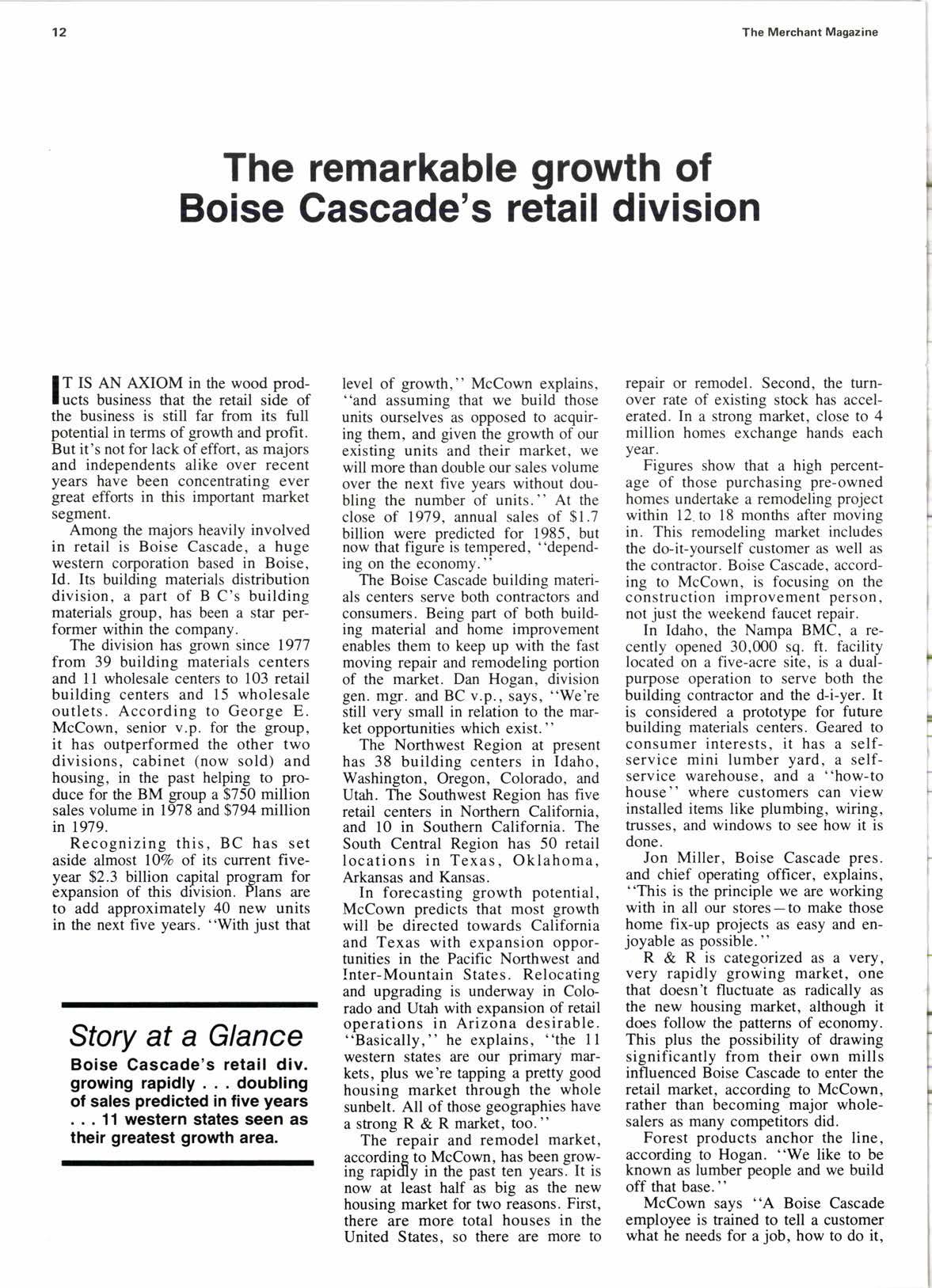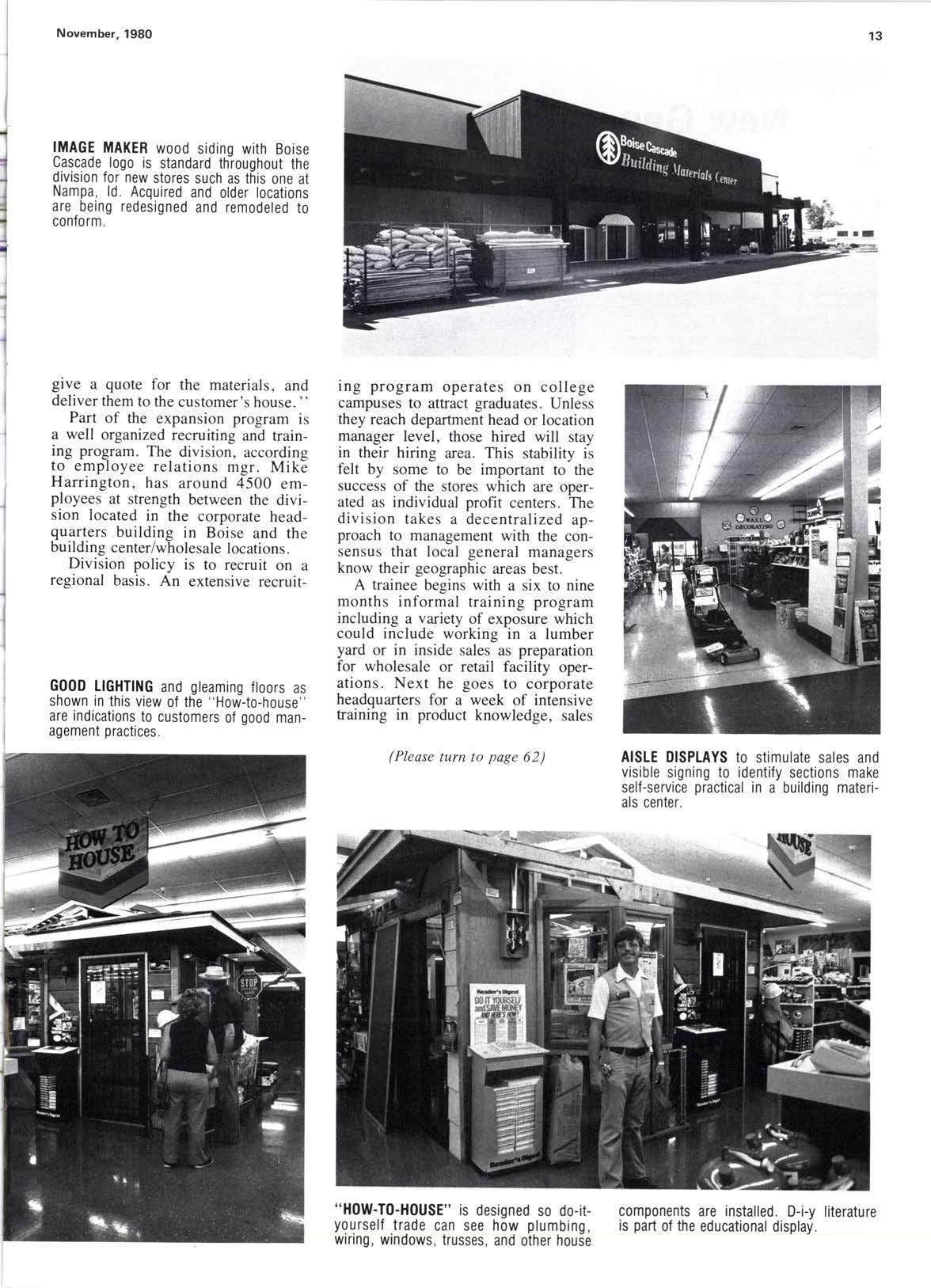
4 minute read
The remarkable growth of Boise Cascade's retail division
lT IS AN AXIOM in the wood prodlucts business that the retail side of the business is still far from its full potential in terms of growth and profit. But it's not for lack of effort, as majors and independents alike over recent years have been concentrating ever great efforts in this important market segment.
Among the majors heavily involved in retail is Boise Cascade, a huge western corporation based in Boise, Id. Its building materials distribution division, a part of B C's building materials group, has been a star performer within the company.
The division has grown since 1977 from 39 building materials centers and 11 wholesale centers to 103 retail building centers and 15 wholesale outlets. According to George E. McCown, senior v.p. for the group, it has outperformed the other two divisions, cabinet (now sold) and housing, in the past helping to produce for the BM group a $750 million sales volume in 1978 and $794 million in I99.
Recognizing this, BC has set aside almost lOVo of its current fivevear $2.3 billion caoital prosram for 6xpansion of this divisiori. Flans are to add approximately 40 new units in the next five years. "With just that
Story at a Glance
Boise Cascade's retail div. growing rapidly . . . doubling of sales predicted in five years level of growth," McCown explains, "and assuming that we build those units ourselves as opposed to acquiring them, and given the growth of our existing units and their market, we will more than double our sales volume over the next five years without doubling the number of units. " At the close of 1979, annual sales of $1.7 billion were predicted for 1985, but now that figure is tempered, "depending on the economy."
11 western states seen as their greatest growth area.
The Boise Cascade building materials centers serve both contractors and consumers. Being part of both building material and home improvement enables them to keep up with the fast moving repair and remodeling portion of the market. Dan Hogan, division gen. mgr. and BC v.p., says, "We're still very small in relation to the market opportunities which exist. "
The Northwest Region at present has 38 building centers in ldaho, Washington, Oregon, Colorado, and Utah. The Southwest Region has five retail centers in Norttrern California. and l0 in Southern California. The South Central Region has 50 retail locations in Texas, Oklahoma, fukansas and Kansas.
In forecasting growth potential, McCown predicts that most growth will be directed towards California and Texas with expansion opportunities in the Pacific Northwest and Inter-Mountain States. Relocating and upgrading is underway in Colo rado and Utah with expansion of retail operations in Arizona desirable. "Basically," he explains, "the 1l western states are our primary markets, plus we're tapping a pretty good housing market through the whole sunbelt. All of those geographies have a stong R & R market, too. "
The repair and remodel market, accordine to McCown. has been growing rapidly in the past ten yearsi It is now at least half as big as the new housing market for two reasons. First, there are more total houses in the United States. so there are more to repair or remodel. Second, the turnover rate of existing stock has accelerated. In a strong market, close to 4 million homes exchange hands each year.
Figures show that a high percentage of those purchasing pre-owned homes undertake a remodeling project within l2.to 18 months after moving in. This remodeling market includes the do-it-yourself customer as well as the contractor. Boise Cascade, according to McCown, is focusing on the constructlon lmprovement person, not just the weekend faucet repair.
In Idaho, the Nampa BMC, a recently opened 30,000 sq. ft. facility located on a five-acre site, is a dualpurpose operation to serve both the building contractor and the d-i-yer. It is considered a prototype for future building materials centers. Geared to consumer interests, it has a selfservice mini lumber yard, a selfservice warehouse. and a "how-to house" where customers can view installed items like plumbing, wiring, trusses, and windows to see how it is done.
Jon Miller, Boise Cascade pres. and chief operating officer, explains, "This is the principle we are working with in all our stores-to make those home fix-up projects as easy and enjoyable as possible. "
R & R is categorized as a very, very rapidly growing market, one that doesn't fluctuate as radically as the new housing market, although it does follow the patterns of economy. This plus the possibility of drawing significantly from their own mills influenced Boise Cascade to enter the retail market, according to McCown, rather than becoming major wholesalers as many competitors did.
Forest products anchor the line, accordins to Hosan. "We like to be known ai lumber-people and we build off that base. "
McCown says "A Boise Cascade employee is trained to tell a customer what he needs for ajob, how to do it, give a quote for the materials, and deliver them to the customer's house. "
IMAGE MAKER wood sidino with Boise Cascade.logo is standard thioughout the drvrsron l0r new stores such as this one at Nampa, ld. Acquired and older locations are.being redesigned and remodeled to c0nt0rm.

Part of the expansion program is a well organized recruiting and training program. The division, according to employee relations mgr. MikE Harrington, has around 4500 employees at strength between the division located in the corporate headquarters building in Boise and the b-uilding center/w-holesale locations.
Division policy is to recruit on a regional basis. An extensive recruit- ing program operates on college campuses to attract graduates. Unless they reach department head or location manager level, those hired will stay in their hiring area. This stability is felt by some to be important to the success of the stores which are operated as individual profit centers. The division takes a decentralized approach to management with the consensus that local general managers know their geographic areas best.
G00D LIGHTING and gleaming ftoors as shown in this view of the "How-to-house" are indications to customers of oood management practices.
A trainee begins with a six to nine months informal training program includine a varietv of exoosure which could in"clude wirrking'in a lumber yard or in inside sales as preparation for wholesale or retail facility operations. Next he goes to corporate headquarters for a week of intensive trainiirg in product knowledge, sales
(Please turn to page 62)
AISLE DISPLAYS to stimulate sales and visible signing to identify sections make self-service practical in a building materials center.










